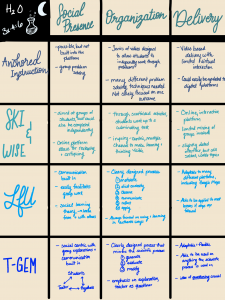In module B, we were introduced to four unique Technology Enhanced Learning Environments; The Jasper Series, WISE, MyWorld and Chemland. Each of these TELEs were discussed in depth using different pedagogical frameworks. MyWorld embedded Learning-for-use (Lfu) framework in their TELE, Chemland integrated TGEM (Technology-enhanced, Generate, Evaluate, and Modify as an approach for their TELE, WISE integrated scaffolded knowledge integration (SKI) in their TELE, and finally the Jasper Series used an anchored approach which involved introducing students to authentic real-world problems through videos.
In many science classes, the textbook is relied on heavily with little emphasis put on hands-on authentic activities that allow students to think critically and build their inquiry skills which is vital for 21st century learning. These TELEs are breaking away from traditional classrooms so that students can collaborate, develop critical thinking skills, and motivate students while increasing cognitive skills using relevant and engaging activities.
When I reflect and think about the commonality between all four TELEs it is that they all put the student at the forefront of their learning and:
- these TELEs use collaborative approaches
- implement authentic real-world problems that are relevant
- use scaffolding as a way for students to build their development of scientific inquiry skills
- all have tenets of constructivism as the foundation
- activities are within the zone of proximal development (ZPD) which means that activities are challenging but not so hard that students would be discouraged
- the role of technology is to enhance student learning not used as a primary mean of teaching and learning
- the frameworks can be used with any age group
- there is an importance put on using and developing inquiry skills
- he concepts/topics/activities are meaningful and engaging
- all the frameworks require active participation from students which lead to creation of new knowledge rather than being passive recipients
- in all four TELEs, we see that an importance is put on how the information is presented: illustrations, displays, simulations, visuals, and videos all play a significant role for student learning and inquiry
- the role of the teacher is that of a facilitator to guide students to construct their own knowledge
Some of the differences that I have seen with the four TELEs are:
- The Jasper videos are outdated which may be a problem for students whereas the other TELEs are quite engaging for students
- The reason and focus for each TELE is different: WISE was designed to integrate science content and scientific inquiry skills. Chemland and MyWorld were designed to incorporate simulations. Jasper was designed so students could use their problem-solving skills that was anchored in a real-world problem.
- WISE allows teachers to edit projects to meet the needs of individual students which promotes individualized learning whereas the other TELEs do not allow for this
My reflection:
In the beginning of this module, we were asked what our own definition of technology was. I said that “to me, technology is all of the tools, techniques, knowledge, and resources that we find useful and that make our lives easier. I also stated that the definition of technology, from all the definitions given by David Jonassen, Webb, Feenburg, Chris Dede, Robert Kozma, Trotter, Muffoletto, and Roblyer, the definition that stood out to me was the statement from Roblyer (2012) in which he describes technology as “technology is us-our tools, our methods, and our own creative attempts to solve problems in our environment.” Yes, the four TELEs that we learned about in this module each have their benefits; however, they should be used to advance our own pedagogical knowledge and our own TPCK.
Even though we have technology at our fingertips, we, as educators, need to be mindful in how we implement it in our classes with our learners. Simply introducing technology to the educational process is not adequate. There should be a purpose to integrating technology in our lessons. The use of technology can be an extremely powerful tool in the science and math classrooms and can influence how students learn. When students are able to visually see abstract concepts, they are better able to understand and engages them in authentic real-world math and science problems that students are able to think critically about and at the same time, able to develop their inquiry skills.
I would definitely use these TELEs in my own practice as the learner is at the center of each approach. Each of our learners deserves to learn in a collaborative learning environment that uses interactive and engaging tools to deepen inquiry skills in a meaningful way which is crucial for 21st century learning. As long as we, the educators, see the importance of these 21st century skills.
